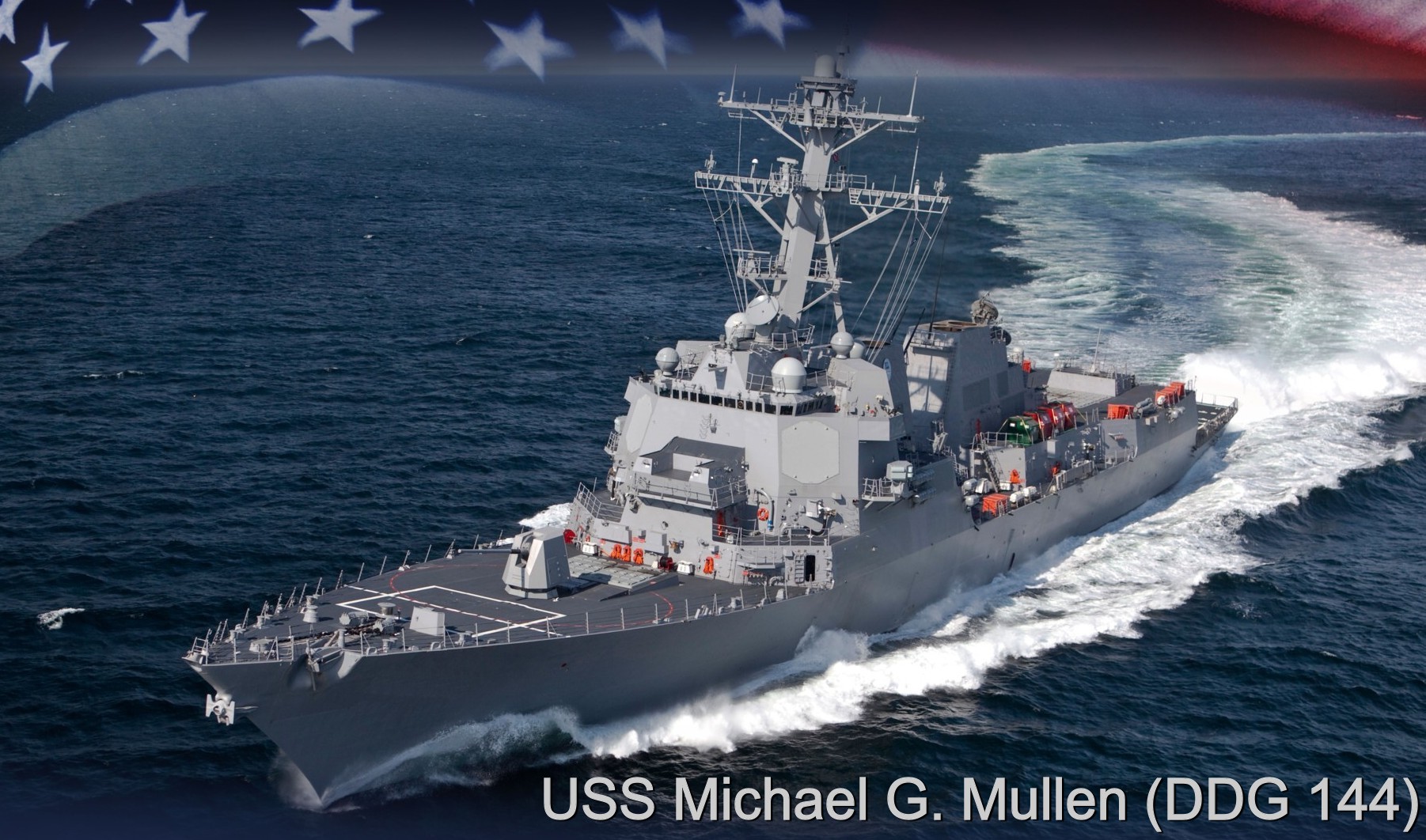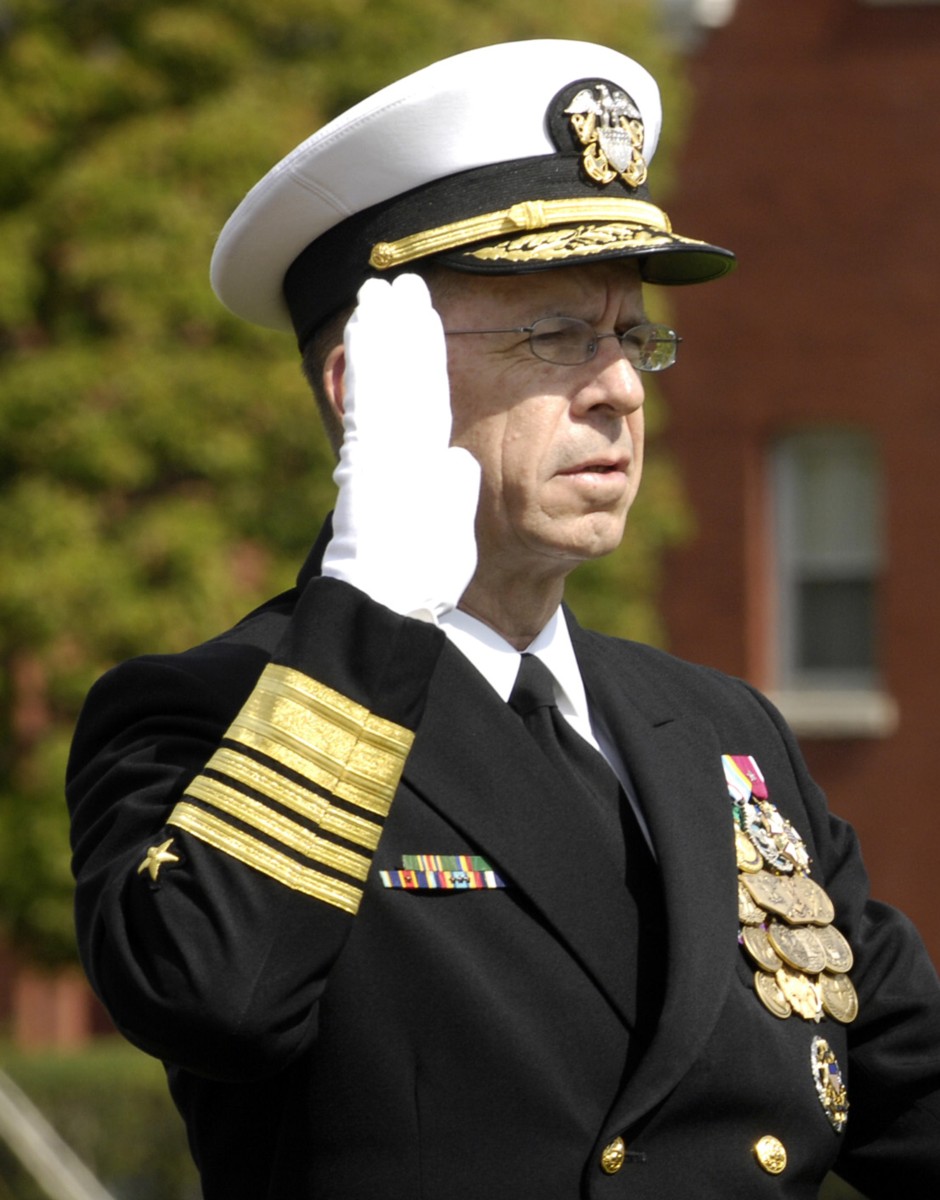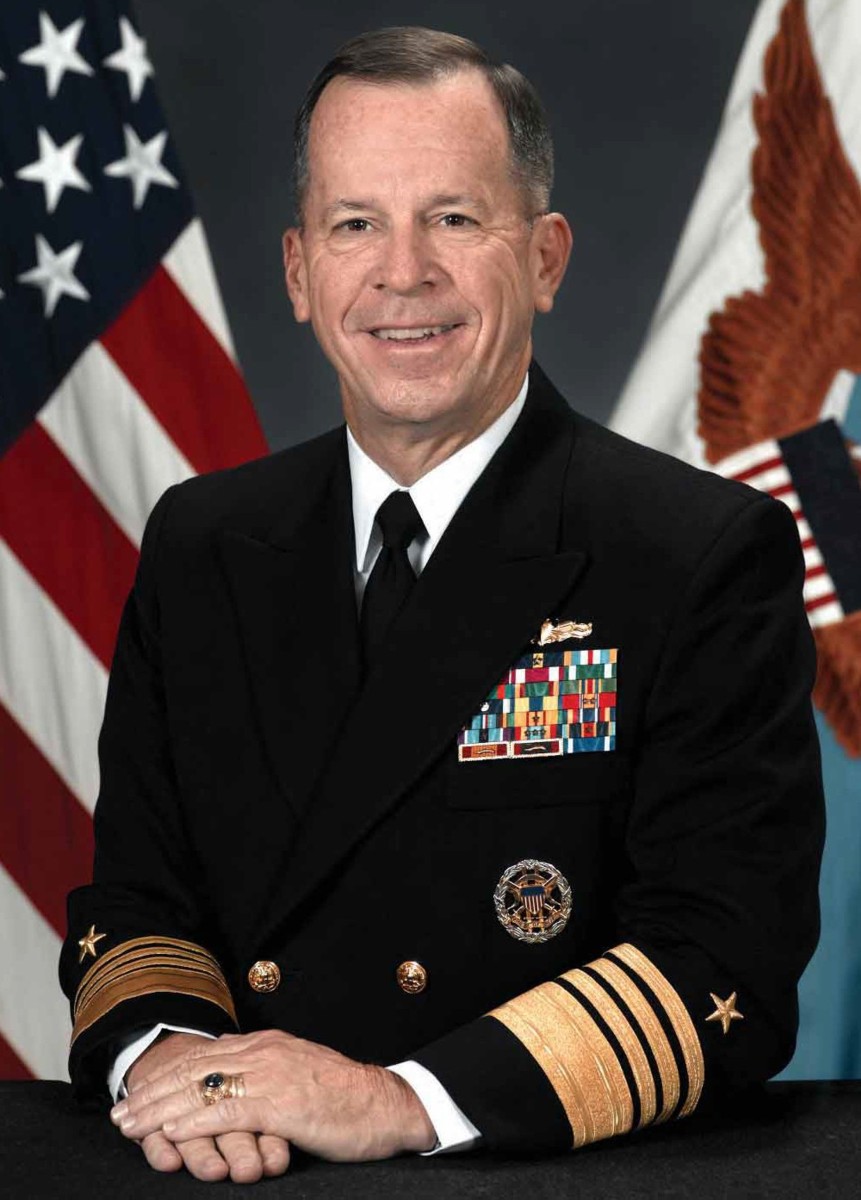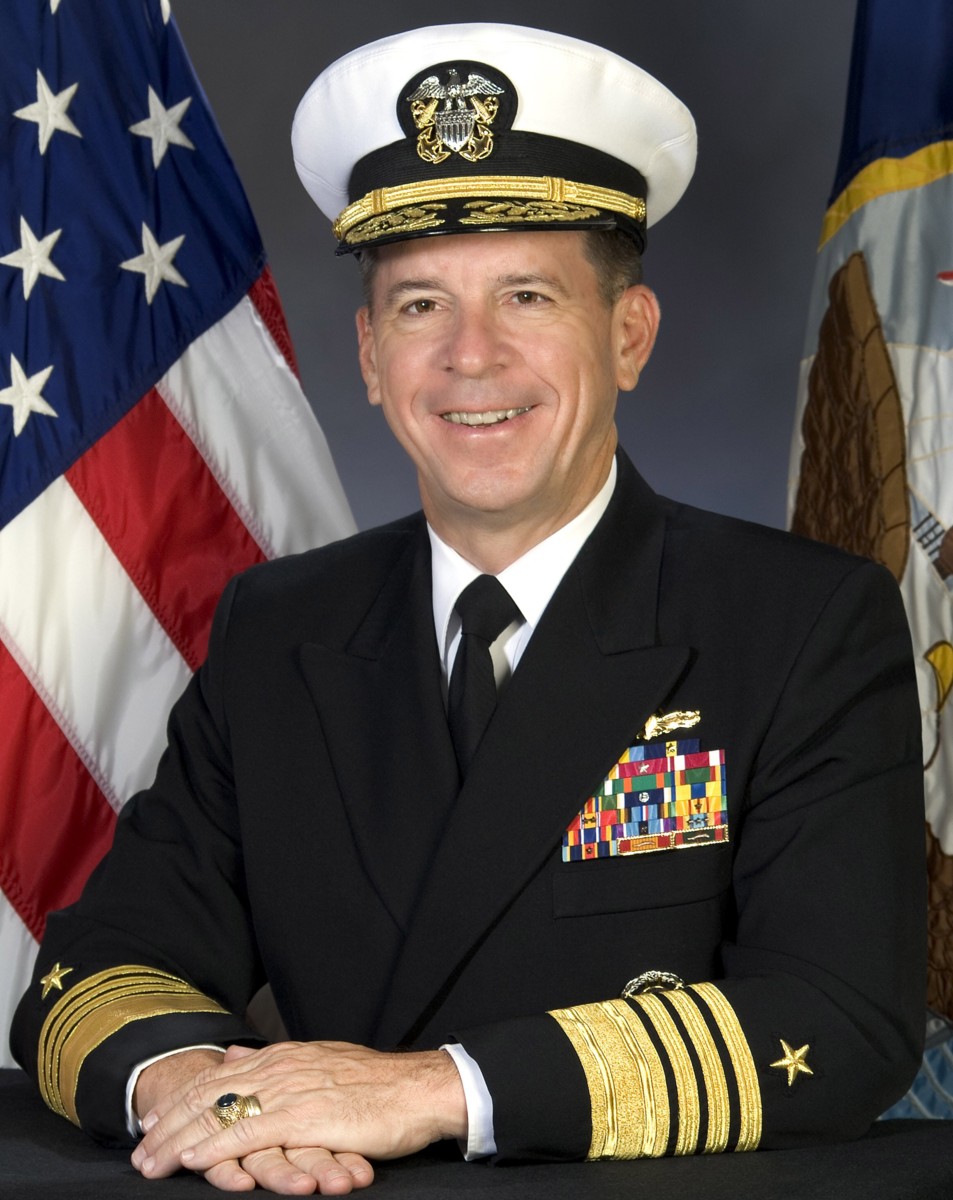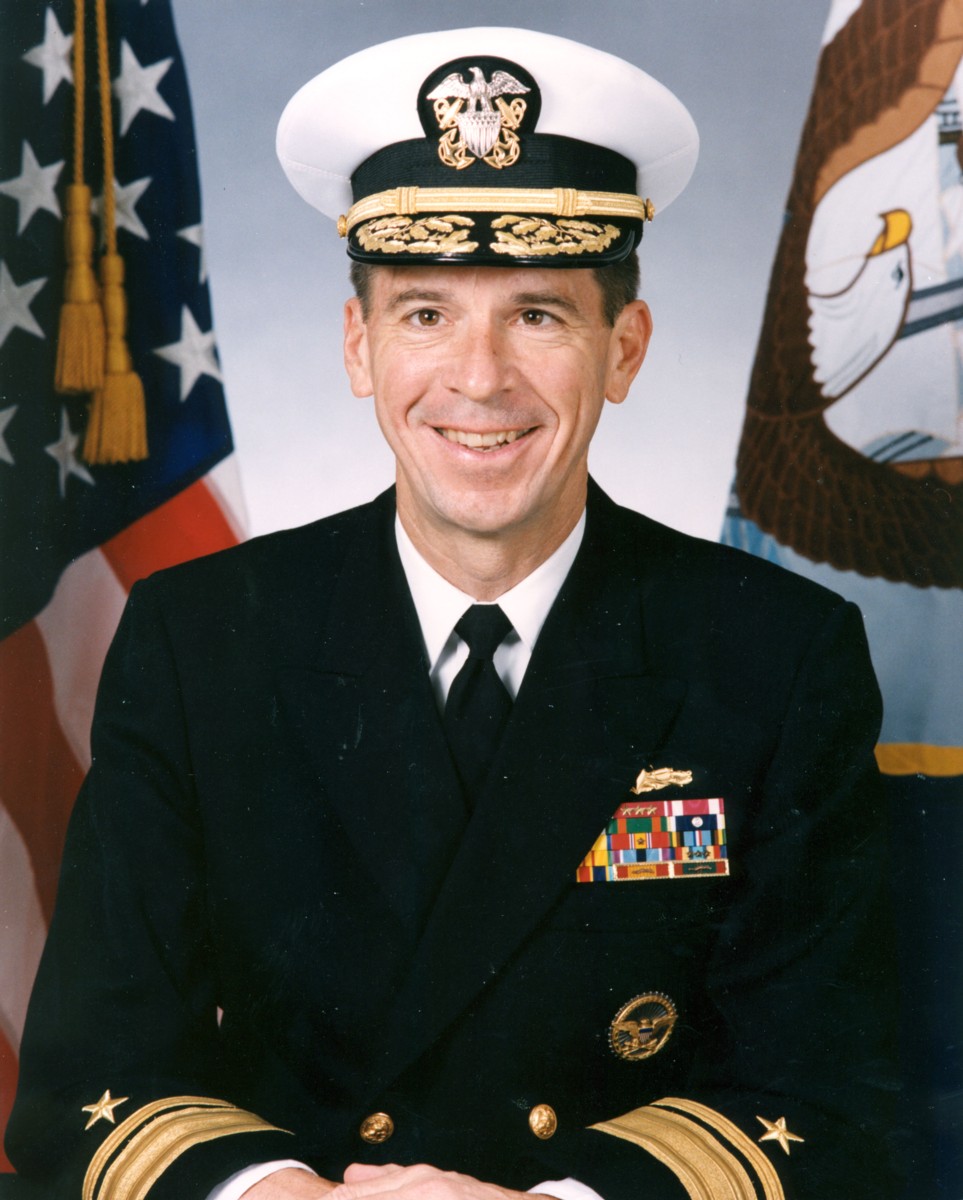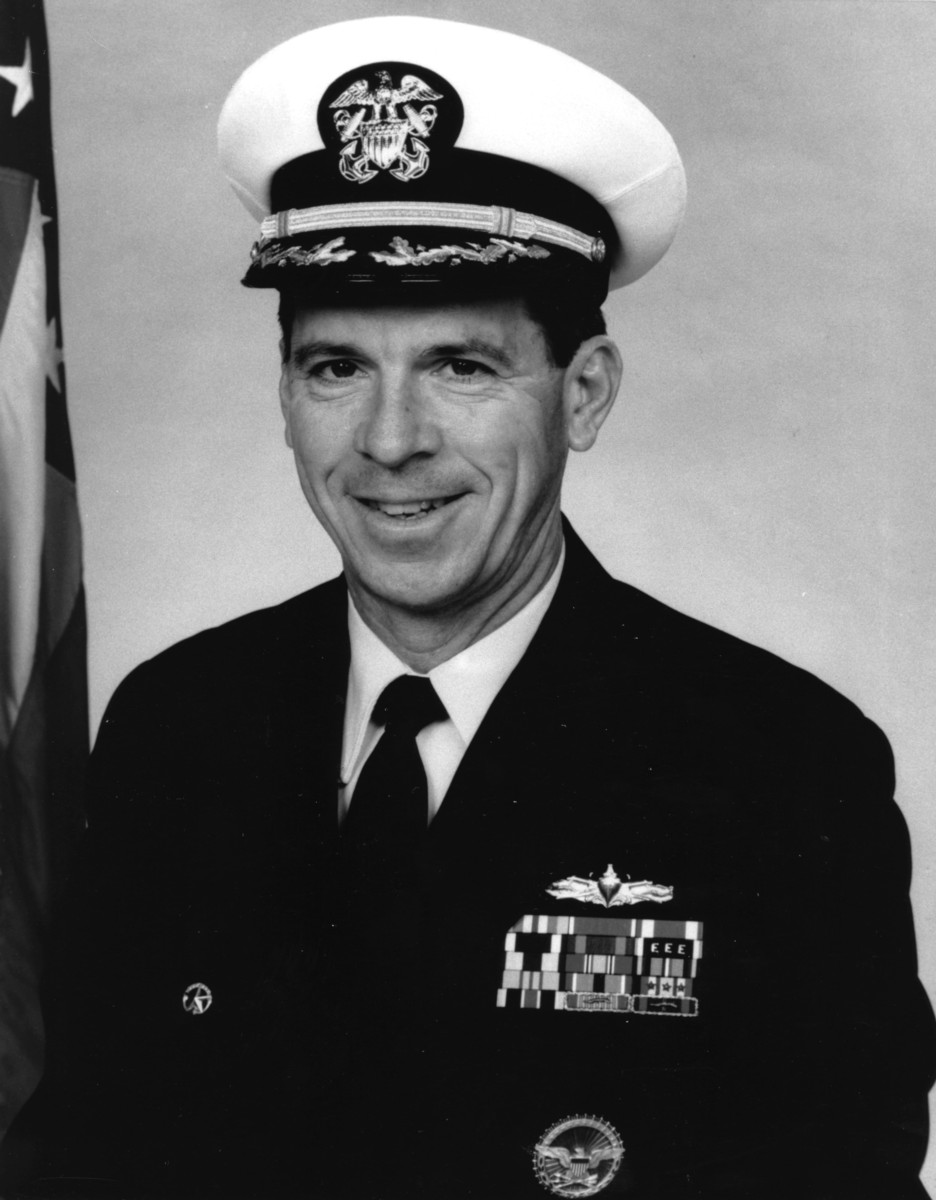 |
||
|
HOME
|
US Navy -
ships
|
US Navy - air
units
|
USMC - air
units
|
International
Navies
|
Weapon Systems
|
Special Reports |
||
|
US Navy - Guided Missile Destroyer DDG 144 - USS Michael G. Mullen |
||
|
||
| 07/24 | ||
|
Type,
class: Guided Missile Destroyer - DDG; Arleigh Burke
class, Flight III Builder: General Dynamics Bath Iron Works, Bath, Maine, USA STATUS: Awarded: authorized Laid down: Launched: Christened: Commissioned: I Homeport: - Namesake: Admiral Michael G. Mullen (1946- ) Ships Motto: Technical Data: see: INFO > Arleigh Burke class Guided Missile Destroyer - DDG |
||
| images | ||
|
|
||
|
USS Michael G. Mullen (DDG 144): |
||
|
Admiral Michael Glenn Mullen ... was born in Los Angeles, California, on 4 October 1946. The son of a prominent Hollywood publicist, he was the eldest of five children. While attending Notre Dame High School in Sherman Oaks he participated in service and social clubs and excelled in basketball, becoming the team’s most valuable player. Following high school he enrolled in the United States Naval Academy at Annapolis, Maryland. Midshipman Mullen graduated on 5 June 1968, earning a bachelor of science degree in systems engineering and a commission in the US Navy. Ensign Mullen reported to San Diego, California, for ten weeks of training in military justice and anti-submarine warfare operations. He then joined the USS Collett (DD 730) in October 1968. Serving as an anti-submarine warfare officer, he oversaw employment of the ship’s Drone Anti-Submarine Helicopter (DASH), an unmanned aircraft armed with torpedoes, designed to extend the destroyer’s stand-off attack capability. He was promoted to lieutenant (junior grade) in June 1969, and that September the destroyer sailed for a six-month deployment to the Western Pacific. As part of Seventh Fleet, the crew participated in operations off the coast of Vietnam, including naval gun fire in support of US Army, US Marine Corps, and South Vietnamese forces near Da Nang. In February1971 Lieutenant (j. g.) Mullen graduated from the Department Head Course 32 at Naval Destroyer School, Newport, Rhode Island. After completing a brief course in nuclear weapons at Norfolk, Virginia, he reported aboard the USS Blandy (DD 943) as Weapons Officer and was promoted to full Lieutenant in July 1971. As part of Destroyer Squadron Twenty-Six, nicknamed “The Mod Squad”, the Blandy participated in an experimental program designed to give junior officers more responsibility by assigning them to billets normally held by personnel of greater rank. While serving consecutively as the ship’s Weapons and Operations Officer, Mullen participated in NATO operations in the Mediterranean, tracked Soviet ships in the Caribbean, and qualified to command destroyers. After completing short courses in damage control and fleet petroleum operations in January 1973, Lieutenant Mullen assumed command of the USS Noxubee (AOG 56), a World War II era gasoline tanker, home ported in Little Creek, Virginia. The crew provided replenishment services to the Atlantic Fleet and completed two successful deployments to the Mediterranean, including providing support to US Navy ships in the eastern Mediterranean during the 1973 Arab-Israeli war. Lieutenant Mullen returned to the US Naval Academy in July 1975. He served two years as a Company Officer for 150 midshipmen, with concurrent assignments as an instructor, a member of the admissions board, and assistant officer-in-charge for summer midshipman training. During his final year at the academy, Mullen was promoted to lieutenant commander in October 1977 and became the Commandant’s executive assistant. To prepare for his next assignment, Lieutenant Commander Mullen completed the five-month prospective engineer officer’s course at Idaho Falls, Idaho, and Great Lakes, Illinois. A month after graduation in October 1978, he reported aboard the USS Fox (CG 33), a guided missile cruiser home ported in Bremerton, Washington, as Chief Engineer. Mullen oversaw a fifteen month overhaul of the ship’s propulsion system, and his department earned two consecutive awards for engineering excellence. The Fox deployed to the Western Pacific in September 1980 and served briefly as flagship in the Persian Gulf during the continuing crisis with revolutionary Iran. During the deployment, Mullen held concurrent responsibilities as the ship’s senior watch officer and force anti-air warfare commander for the USS Ranger Aircraft Carrier Battle Group and combatant forces operating in the Persian Gulf. In July 1981, after completing a short course in surface ship operations at Newport, Rhode Island, Lieutenant Commander Mullen became the Executive Officer of the USS Sterett (CG 31), home ported in Subic Bay, Republic of the Philippines, while supporting Seventh Fleet operations in the Western Pacific. This involved battle group and multilateral exercises with partner nations, including Japan and the Republic of Korea, and included an encounter with a Vietnamese fishing boat that fired upon the task group. The Sterett also recovered Vietnamese nationals at sea who were fleeing from South Vietnam. While attending the Naval Postgraduate School at Monterey, California, from January 1983 to March 1985, Lieutenant Commander Mullen advanced in grade to Commander and earned a master of science degree in operations research. After completing a brief refresher course in ship operations at Newport, Rhode Island, Mullen transferred to Pearl Harbor, Hawaii, and took command of the USS Goldsboro (DDG 20) in June 1985. The guided missile destroyer executed Third Fleet operations until August 1986, when it deployed to the Western Pacific and Persian Gulf. As part of the Middle East Force from November to January 1987, the crew conducted maritime security operations under wartime conditions during the Iraq-Iran conflict. In recognition of his performance while commanding afloat, Mullen received the Pacific Fleet’s 1987 Vice Admiral Stockdale Leadership Award. Commander Mullen returned to Newport, Rhode Island, in October 1987. After completing the integrated warfare course for post-command officers at the Naval War College, in December he assumed the duties of Director of the Surface Warfare Division Officer Course. Promoted to captain in September 1989, Mullen transferred to Washington, DC, where he became the Navy’s Staff assistant to the Director for Operational Test and Evaluation at the Office of the Secretary of Defense (OSD). He was involved in modernization initiatives such as the Arleigh Burke class (DDG 51) guided missile destroyer, the AEGIS SPY-1B radar testing and evaluation, improvements to the Standard Missile capabilities, Seawolf-class (SSN 21) submarine, and Tomahawk missile programs. As OSD pursued its new “Fly-before-Buy” procurement strategy, he proved especially adept at enhancing evaluation methods, drafting technical assessments for the Defense Acquisition Board, and briefing members of Congress. Captain Mullen next completed the 11 week Advanced Management Program at Harvard Business School in November 1991, followed by command refresher training in Rhode Island and Virginia. In April 1992 he assumed command of the AEGIS guided missile cruiser USS Yorktown (CG 48), that year’s Atlantic Fleet winner of the Marjorie Sterrett Battleship Fund Award for overall readiness. With the Cold War ended, the ship visited Severomorsk, Russia, and trained with the Romanian and Bulgarian navies. The crew earned another award for battle efficiency during 1993, while conducting counter-drug operations in the Caribbean as part of Joint Task Force (JTF) 4 and maritime interdiction operations off Haiti as part of JTF-120 during Operation SUPPORT DEMOCRACY. In each case Mullen served as the force’s air warfare commander. He also embarked women aboard the Yorktown on a temporary basis in an effort to enhance diversity and opportunity in the Navy. Returning to Washington in February 1994, Captain Mullen served as Director of the Surface Officer Distribution Division at the Bureau of Naval Personnel. This was a tumultuous period, characterized by reductions in personnel, resources, and ultimately the size of the fleet. He implemented changes in personnel assignments to complement the new force structure, including initiatives to realign career paths, increase command opportunities for younger officers, broaden opportunities for joint education and joint assignments, and institutionalize diversity. In August 1995 Mullen became Director of the Surface Warfare Plans, Programs, and Requirements Division in the Office of the Chief of Naval Operations. As the SC-21 (Surface Combatant for the 21st Century) program entered the cost and operational analysis phase of development, he advocated the addition of distributed system networks and extended-range precision weapons to the Arsenal Ship design. Following his promotion to flag rank on 1 April 1996, Rear Admiral (lower half) Mullen served briefly as the Deputy Director of the Surface Warfare Division and completed refresher training at Oceana, Virginia. Then, in August he took command of Cruiser-Destroyer Group TWO, with concurrent duties as commander of the USS George Washington (CVN 73) Aircraft Carrier Battle Group. The battle group participated in inter-deployment training as part of the Atlantic Fleet until October 1997, when it deployed to the Mediterranean Sea and Persian Gulf. George Washington participated in multi-battle group operations in the Gulf as the cornerstone of US Central Command’s military presence in the Middle East. Central Command forces during this time nearly came to blows with the Iraqi military, first in December 1997 and then again in February 1998. The presence and readiness of US forces eventually helped convince Saddam Hussein to allow United Nations weapons inspectors into Iraq. Newly promoted Rear Admiral (upper half) Mullen returned to the Office of the Chief of Naval Operations in May 1998, this time as Director of the Surface Warfare Division (N-86). Inheriting a reduced force with growing littoral responsibilities, he told Congress, “we can no longer safely mortgage our future readiness by further deferring recapitalization and modernization.” Advocating a “measured revolution” that acknowledged fiscal limitations, he addressed retention issues through systems automation, continuation pay, and reduced sea-time. He also sought a modest increase in shipbuilding and installed new technologies aboard existing vessels. Among several key 21st Century initiatives were the tactical Tomahawk cruise missile, theater ballistic missile defense, and the multi-mission DD-21 destroyer programs. In October 2000 Vice Admiral Mullen accepted concurrent command of the US Second Fleet and NATO Striking Fleet Atlantic, embarked upon the USS Mount Whitney (LCC 20). The Second Fleet operated from the North to the South poles and as far east as Europe. Besides training the Atlantic battle fleet, evaluating new tactics, and maintaining battle group readiness, Mullen could also assemble JTF-120 to address emergent regional crises. The Striking Fleet maintained maritime superiority in the Atlantic and guaranteed NATO’s sea lines of communication. Vice Admiral Mullen returned to Washington in August 2001 as the Deputy Chief of Naval Operations for Resources, Requirements, and Assessments (N-8) in the Office of the Chief of Naval Operations (CNO). During his two-and-a-half-year tenure, Mullen improved the efficiency of the Navy’s acquisition process and identified program cuts to recapitalize funding for force modernization and transformation. A principal architect of Sea Power 21, the CNO’s strategic vision to address 21st Century threats, he advocated for a Global Concept of Operations that reconfigured naval forces to create additional expeditionary strike groups. This enabled the fleet to expand its geographic scope of influence and enhance the nation’s deterrence capability. Following his promotion to admiral in August 2003, Mullen was appointed the Vice Chief of Naval Operations. He represented Navy interests as a member of the Joint Requirements Oversight Council and led implementation of the CNO’s Fleet Response Plan, designed to replace rigid Cold War-era training, maintenance, and deployment cycles with a more flexible timetable that increased the fleet’s surge capacity. In October 2004 Admiral Mullen took concurrent command of US Naval Forces, Europe, and Allied Joint Force Command, situated in Naples, Italy. In this dual role he commanded the Combined and Joint NATO Force in the Balkans (17,000 troops in Kosovo), coordinated ongoing NATO counterterrorism efforts in the Mediterranean during Operation ACTIVE ENDEAVOR, and stood up the first NATO training missions in Iraq (NTM-I). This varied experience provided a fresh understanding of the dynamic global changes and an appreciation of the need for a secure environment to allow democracy and opportunity to flourish. Eight months later, on 22 July 2005, Admiral Mullen became the 28th Chief of Naval Operations. His initial guidance to the Navy identified three priorities: sustaining combat readiness, building a fleet for the future, and developing 21st Century leaders. Readiness meant maintaining a responsive force - ships and personnel - with a wide range of operational capabilities. Mullen again sought to harness the nation’s diversity, empowering sailors to reach their full potential. Dedicated to developing the Sea Power 21 vision, Admiral Mullen began to “build today a force that is properly sized, balanced, and priced for tomorrow.” To bolster the nation’s flagging shipbuilding industry, he recommended replacement of aging vessels and expansion of the current fleet to 313 ships by 2020. Much of the fleet’s anticipated growth was linked to a new multi-mission littoral combat ship, which would reduce costs and improve the Navy’s capability to deal with terrorist threats and humanitarian crises world-wide. Admiral Mullen also championed revamping the National Fleet Policy between the Navy and Coast Guard and led the naval services to update the united maritime strategy in “A Cooperative Strategy for 21st Century Seapower.“ The global strategy established dispersed fleet stations to build international relationships and sustain the joint fleet’s constant forward presence. Acknowledging growing requirements for interoperability among maritime nations sharing similar interests, Mullen proposed that allies collaborate to form a “Thousand Ship Navy” to secure the “global maritime commons.” He envisioned a “free-form, self-organizing network of maritime partners” facilitated by the implementation of an automatic identification system for ships at sea and the creation of a Virtual Regional Maritime Traffic Center. Based on the recommendation of Dr. Robert M. Gates, the Secretary of Defense, Admiral Mullen became the 17th Chairman of the Joint Chiefs of Staff on 1 October 2007. Mullen arrived in the midst of the Global War on Terrorism and two wars and immediately established three priorities that would resonate throughout his four-year tenure as Chairman. His first priority was to develop a strategy to protect the nation’s interests in the Middle East, then dominated by the ongoing campaigns in Iraq and Afghanistan. As CNO, Admiral Mullen supported President Bush’s temporary troop surge in Iraq, support that was made possible through the Chiefs’ collective insistence that the surge would be accompanied by economic development and political reconciliation. During his confirmation hearings for Chairman, he testified that America’s ground forces were severely strained, but defeat would strengthen the nation’s adversaries and further undermine Middle East stability. Security conditions in Iraq had improved by the fall of 2007, enabling the additional US forces to start to gradually withdraw. Nonetheless, Admiral Mullen made clear that the Iraqi security forces still needed American military assistance to counter insurgent and terrorist violence. A base force would have to remain in place until the Iraqis were sufficiently trained and equipped. In November 2008, after much debate, the Iraqi Parliament accepted a status of forces agreement with the United States that restricted US combat operations and called for an intermediate withdrawal of American forces from major cities by June 2009, followed by their complete departure by the end of 2011. Relegated by necessity to an economy of force mission, the situation in Afghanistan and neighboring Pakistan worsened during 2007. Frustrated by NATO shortfalls in capability and capacity, Admiral Mullen called for “a well-coordinated counterinsurgency strategy.” He also started an effort for alternative logistics supply to reduce reliance on Pakistan. As the Bush administration reassessed its military and diplomatic strategies the following year, Mullen acknowledged that coalition forces were losing ground and advocated greater involvement. “In Afghanistan, we do what we can,” he told members of the House Armed Services Committee in December 2007. “In Iraq, we do what we must.” He also initiated a long-term diplomatic relationship with General Ashfaq Kayani, the Pakistani Army Chief of Staff, pledging support and soliciting cooperation in combating militants in the country’s unruly tribal area. Shortly after his inauguration in 2009, President Obama shifted the military’s focus from Iraq to Afghanistan, presented a new counterinsurgency strategy for the region, and increased the number of deployed forces. He pledged collaboration with Pakistan in the fight against terrorism and emphasis on more resources for training security forces, fighting government corruption, and combating drug trafficking in Afghanistan. By January Admiral Mullen was repeatedly warning about the detrimental effect that poor governance and corruption was having on the population. “Despite a dramatic increase in our civilian presence in Afghanistan this past year,” Mullen told members of the House Armed Services Committee in February 2011, “improvements in sub-national governance and reconstruction have not kept pace with progress in improving security. This has impeded our ability to hold, build and transfer.” There were further gains in security - particularly in the south and east over the spring - and a robust effort to continue to grow and develop competent Afghan security forces. Admiral Mullen worked with special operations forces to provide options for the President for operations against Osama bin Laden in the spring of 2011, the execution of which resulted in the killing of Osama bin Laden. Together these developments made it possible for Admiral Mullen to support President Obama’s plan to withdraw US troops and turn over security to Afghan forces by 2014. He advised a cautious approach, however, to ensure that the drawdown did not occur too swiftly. Admiral Mullen’s second priority as Chairman was to improve the health of the force by balancing current requirements against future national security threats. The toll taken on US ground forces during protracted wars in Iraq and Afghanistan particularly worried him, and Mullen questioned their readiness to fight a high-intensity war against a major adversary. Besides repairing or replacing worn out equipment, he proposed increasing the interval between deployments, training to full-spectrum operations, and addressing the welfare of service members and their families, especially the needs of the combat wounded and families of the fallen. Mindful of the costs of such initiatives, he suggested that the country devote additional resources to national security and considered a defense budget pegged at 4 percent of its gross domestic product the absolute minimum. The recession in 2008 challenged modernization efforts, compelling Admiral Mullen to acknowledge that the federal debt represented “the single biggest threat to national security.” During the next three years the Chairman and Secretary Gates aggressively trimmed expensive, redundant, or failing programs in order to recapitalize funds for higher priority requirements. They curtailed multiple high-technology items, disestablished US Joint Forces Command, and ultimately reduced the end strength of the Army and Marine Corps to support the all-volunteer force, meet current operational needs, and address the most-likely future threats. Nevertheless, in April 2011 President Obama ordered another $400 billion in reductions over the next twelve years. Admiral Mullen agreed that the Defense Department should contribute to resolving the nation’s deficit crisis and believed that it could responsibly manage a builddown, but he worried that reckless cuts could hollow the military. Admiral Mullen voiced concern over a widening gulf between the military and the public. Even though the military enjoyed what he called a “Sea of Goodwill” on the part of the American people, only a small percentage of the general population had a personal connection to those in uniform. He and his wife Deborah urged communities to embrace returning veterans, and he called on the military to remember, as well, their own duties of citizenship. The most controversial issue separating civil and military values was a matter of enlistment criteria. Mullen had been concerned about the issue for years, and in 2008 he ordered his Staff to conduct a serious study about the ramifications to the force. He privately decided to support a change to the “Don’t Ask, Don’t Tell” policy. During his January 2010 State of the Union Address, President Obama reiterated his pledge to end Don’t Ask, Don’t Tell, a policy that barred gays and lesbians from serving openly in the military. A week later, Admiral Mullen endorsed the President’s plan before members of the Senate Armed Services Committee, testifying, “no matter how I look at the issue, I cannot escape being troubled by the fact that we have in place a policy which forces young men and women to lie about who they are in order to defend their fellow citizens.” When released in late November, the anticipated Pentagon study concluded that allowing gays and lesbians to serve openly would present minimal risk to military effectiveness. President Obama subsequently signed the repeal into law on 22 December and nine months later, after Admiral Mullen, Secretary Leon Panetta, and President Obama “certified” to Congress that the military was ready to execute the new policy, Don’t Ask, Don’t Tell officially ended on 20 September 2011. Admiral Mullen’s third priority was to balance strategic risk around the globe. His 2011 National Military Strategy envisioned “a ‘multi-nodal’ world characterized more by shifting interest-driven coalitions based on diplomatic, military, and economic power, than by rigid security competition between opposing blocks.” In this dynamic environment, he advocated an interagency approach to foreign policy in which military leaders played a wide range of supporting roles. Chinese military modernization and expansion, and North Korean and Iranian nuclear proliferation, he believed, presented particularly significant risks to regional stability and open access to the global commons. To mitigate these risks he proposed a geographically distributed, operationally resilient, and politically sustainable expeditionary force capable of conducting full-spectrum operations with its international partners. The establishment of US Africa Command in 2007 and US Cyber Command in 2010 reflected the wide range of emerging 21st century challenges. Admiral Mullen was an active military diplomat and statesman, encouraging improved military-to-military relations throughout the world. He met frequently with the Chief of Staff of the Pakistani Army, leading efforts to establish a more collaborative association with that country. He also led the US delegations that successfully negotiated nuclear arms reductions (New Start Treaty) with the Russians; met with the Chinese, Japanese, and South Korean chiefs to ease tensions in East Asia; and laid the groundwork for increasing America’s presence in the Pacific. Perhaps Admiral Mullen’s greatest diplomatic challenge occurred near the end of his tenure as Chairman, during the unanticipated Arab Spring of 2011, when a wave of popular uprisings confronted authoritarian regimes throughout the Middle East. He met with senior officials from several Gulf States to encourage tolerance and decry escalating violence. Once President Obama decided to support the U.N. Security Council’s resolution to protect civilians in Libya, he led NATO and Arab allies to quickly establish a no-fly zone and supported subsequent operations that resulted in the demise of the Qaddafi regime. Admiral Mullen left Office on 1 October 2011. He retired one month later, after serving over forty-three years in uniform.
|
||
| patches + more | ||
|
|
seaforces.org |
USN ships
start page | |
